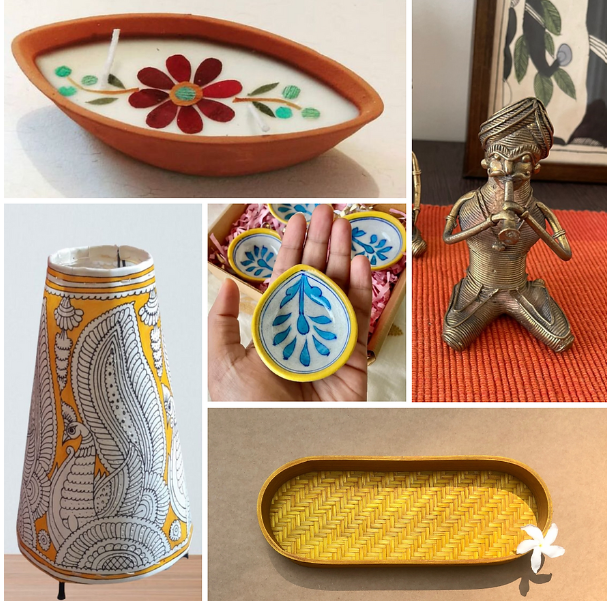
Imagine this - you don’t have GPS on your phone or say, a map of where you are traveling to in India and your only knowledge of directions is interactions with locals; whether in the busiest cities or the remotest villages… What would that experience be? I think you will be more found than lost - found in the midst of exotic and extraordinary cultures, languages and traditions, across the lengths and breadths of this beautiful country. And, an important element preserving the legacy of these diversities is handicrafts.
India is indeed a vibrant diamond of unique handicrafts - once you look closely into the picture, that’s what you will say too! Among the other unique things that our nation carries in its name, the handicraft sector honors it the most. It is an industry that has survived the ravages of time and tide for 5000 glorious years; one that has been honed and reworked according to trends, beliefs and needs which is still looking towards carrying its heritage for 5000 more.
The popularity that the industry has gotten over time is an ode to the impeccable work of artisans known by various names according to their artform. The sustenance of this sector is extremely important to our nation as it is an employment generator for the masses and sustainable for nature.
A few handicrafts from various parts of the country have become extremely popular as corporate gifting items, gifts for one’s kith and kin, and decorative ornaments because they are advocates of a sustainable environment, eco-friendly and are presents with utility!
Bon voyage, traveler; suit yourself to be mesmerized -
Open your eyes to the arid but elegant city of Jaipur, Rajasthan, where Blue pottery is considered as a traditional craft. The tranquil turquoise color used for the pottery comes from filtering the mix of copper oxide with salt or sugar in a kiln. Use of this blue glaze has an interesting origin - developed by Mongol artisans who combined the Chinese glazing tech with Persian decorative arts. The pottery is made from quartz unlike general pottery that is made of clay making it crackproof, hygienic and suitable for everyday use! Although found in Jaipur, and a few other places, it has Turko-Persian roots. The patterns are inspired from the Mughal era arabesque patterns, and even animal motifs. Despite facing numerous challenges, the industry provides livelihood to about a lakh craft persons in the vicinity. It has adapted to the needs of its customers and contributes significantly towards economic growth with its diversified range of products. I hope your eyes caught the beautiful specks of blue in the nooks and corners of Jaipur!
Home to the mighty mangrove forests, the Sundarbans, West Bengal is a bamboo-rich state treasuring the ancient craft of Basketry. The bread-earner for many artisans in the state, the craft seems to have been passed down by their forefathers with little traceability to its origin. The Sabai grass has been a savior for the women in the state, a liberation from confinement in their homes. ‘Grass to Grace’ - they have created more products from these raw materials than their ancestors had ever seen! The Centre of Excellence on Sal & Sabai at Jhargram developed by a West Bengal state board looks to provide a holistic experience to about 20,000 women engaged in Sal and Sabai products. States like Odisha and Kerala have volumes to tell on the tribes that thrive on bamboo produce. It is indeed time to amplify these beautiful stories, isn’t it?
The glimmering mirrors and bold shades of red, blue characterizes the Lambani embroidery particularly found in the arid region of Hampi, Karnataka. With about 14 types of stitches, 13 colors, dyes ranging from vegetable to artificial, and the use of shells and coins; Lambani handicrafts definitely have a unique place in the hearts of many! The Lambani tribe (also called Banjaras) still hold steadfast to their elaborate dressing sense and this sight is a favorite to the tourists who indulge in flamboyant bags, bedsheets, cushion covers, jewelleries and shawls. Amidst the rustic setup of Hampi, Lambani products are the perfect balance to bring out a pop of color in the region!
Remember the ‘dancing girl’ artifact (Mohenjo-daro) from our history textbooks? It is one of the earliest known lost-wax artifacts, famously known as Dhokra! Dhokra metal crafts are very famous due to its underlying simplicity yet magnificent attention-to-detail by the artisans. There are two main processes for this artform; solid casting which is predominant towards the south and hollow casting found in central and eastern India. The tribals of Bastar continue to carry the fortunes of the Dhokra craft despite its laborious and time-consuming nature. The aesthetic is so popular that it has lasted for over 4000 years and has still remained as a collector’s delight!
Although there are countless indigenous crafts that have succumbed to the scars of time, there are many more artisans who devote their lives to their art forms to save and preserve our culture. Mahatma Gandhi once said, “A nation’s culture resides in the hearts and in the soul of it's people.” So, let the spirit of our culture reign in our hearts by encouraging and reviving handicrafts, going ‘vocal for local, supporting artisans and social enterprises that envision a vibrant future with stories from the past to tell! Log on to Ahavah Crafts to trail on this wonderful journey!
- Written by Anne Susan Varghese
(To know more about Anne you can find her at : https://www.linkedin.com/in/anne-susan-varghese-236550224)

